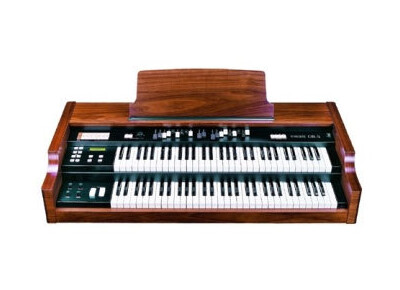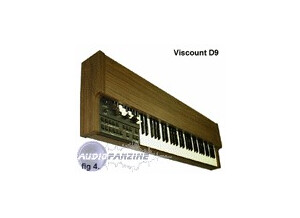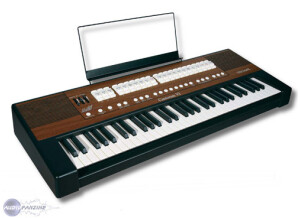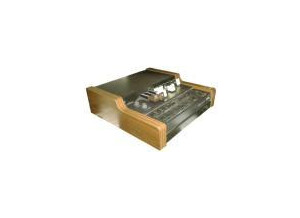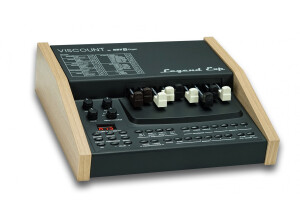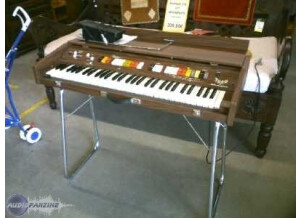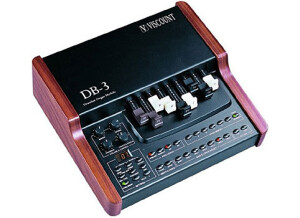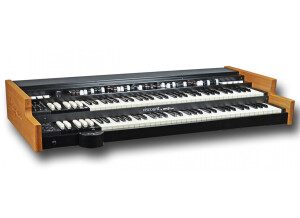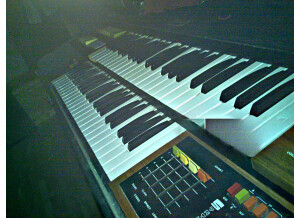Où acheter DB 5 ?
Moins
Il n’y a pas de petite annonce pour ce produit.
Fiche technique
Orgue VISCOUNT DB5 à 2 claviers
Clone du HAMMOND B3 numérisé.
En plus d’un beau meuble en bois naturel, il sonne comme un B3. Toutes les caractéristiques du B3 sont présentes :
- Son « roue phonique »
- Effets vibrato, chorus, distorsion, ...
- Un clavier « upper » avec 9 tirettes harmoniques
- Un clavier « lower » avec split à droite : 9 tirettes harmoniques pour l’accompagnement + 2 tirettes harmoniques pour les basses.
- Réglages indépendants pour chaque clavier
- Claviers à toucher « waterfall » identiques à ceux du B3
- Effet « Leslie » numérique intégré : rotation, accélération, identique à la L122
- Commande de l’effet « Leslie » au pied ou à la main gauche
- Pédale de volume
- Pédale de commande d’effet « Leslie »
Connexions
- Prise 9 broches pour raccordement éventuel d'une cabine Leslie (la L122 est recommandée)
- Prise VGA 15 broches pour raccordement de pédalier 13 ou 25 touches
- Sorties coaxiales L+R+L/R vers ampli
- Prises OUT audio
- Prises MIDI
- Prise casque audio
Meuble :
- Belle menuiserie en placage bois verni noyer.
»
Avis utilisateurs
4.0/5(3 avis)
5
4
100 %
3
2
1
Bon rapport qualité/prix en occasion pour un premier investissement
Publié le 12/04/21 à 05:37Bonsoir !
Cet avis est un peu "à titre posthume", car je viens de vendre mon DB5.
En réalité, le Viscount DB5 est un Oberheim OB5 : en témoigne le manuel d'utilisation auf Deustch et le marquage ajouté par Viscount.
Et Oberheim savait bien faire les choses.
Acheté neuf en fin de commercialisation chez Thomann, il était destiné à un service fixe purement de loisir.
Durant ces quatre ans, il a très bien rempli son rôle.
Je jouais dessus un peu de tout, depuis Jimmy Smith jusqu'à des adaptations perso de répertoire français genre Piaf ou Ferré !!!
Branché sur une simple paire d'enceintes Presonus Eris E5, le son est très satisfaisant.
Tout au plus peut-on trouver les basses ( le 16 ' et le...…
Cet avis est un peu "à titre posthume", car je viens de vendre mon DB5.
En réalité, le Viscount DB5 est un Oberheim OB5 : en témoigne le manuel d'utilisation auf Deustch et le marquage ajouté par Viscount.
Et Oberheim savait bien faire les choses.
Acheté neuf en fin de commercialisation chez Thomann, il était destiné à un service fixe purement de loisir.
Durant ces quatre ans, il a très bien rempli son rôle.
Je jouais dessus un peu de tout, depuis Jimmy Smith jusqu'à des adaptations perso de répertoire français genre Piaf ou Ferré !!!
Branché sur une simple paire d'enceintes Presonus Eris E5, le son est très satisfaisant.
Tout au plus peut-on trouver les basses ( le 16 ' et le...…
Lire la suite
Bonsoir !
Cet avis est un peu "à titre posthume", car je viens de vendre mon DB5.
En réalité, le Viscount DB5 est un Oberheim OB5 : en témoigne le manuel d'utilisation auf Deustch et le marquage ajouté par Viscount.
Et Oberheim savait bien faire les choses.
Acheté neuf en fin de commercialisation chez Thomann, il était destiné à un service fixe purement de loisir.
Durant ces quatre ans, il a très bien rempli son rôle.
Je jouais dessus un peu de tout, depuis Jimmy Smith jusqu'à des adaptations perso de répertoire français genre Piaf ou Ferré !!!
Branché sur une simple paire d'enceintes Presonus Eris E5, le son est très satisfaisant.
Tout au plus peut-on trouver les basses ( le 16 ' et le 51/3) pas tout à fait assez rondes.
Mais sincèrement, pour avoir joué sur un C3 et sur divers spinet, dont certains assez fatigués, ce qu'on entend est vraiment très près d'un Hammond, et bien plus convaincant que ce qui sortait des « Hammond » de la génération à transistors des années 7O !
Les percus rendent très bien, et les plages d'ajustage sont larges, permettant de s'approcher très près
du son des roues phoniques.
Le vibrato scanner mérite la même appréciation.
La réverbération est bien pensée, et le « spring » ( ressort) quasiment indiscernable d'un vrai.
Sauf si on secoue l'instrument comme le faisait Keith Emerson ...
Les réglages annexes sont précis et nombreux, plus fins que ceux de certains clones récents très appréciés. Un exemple pour le key-click : on peut ajuster le bruit d'attaque et de relâchement séparément.
La simulation du bruit de fond est très bonne, y compris pour le moteur électrique des originaux à roues phoniques.
Du point de vue du MIDI, toutes les adaptations sont possibles.
Par exemple, celle d'un pédalier Viscount Legend de 25 notes ne pose aucun problème.
On peut sans difficulté passer le pédalier « en tirasse » sur l'un ou l'autre manuel, ce que les gens qui jouent un répertoire classique apprécieront.
L'instrument est très bien construit, et toutes les commandes par boutons sont restées fiables.
Le seul petit bémol concernerait la simulation de Leslie : elle est déjà très bonne, mais surclassée par un Neo Ventilator ou encore mieux un GSI Burn, à cause de l'étage d'entrée à lampe.
Il faut avoir utilisé les véritables Leslies à lampes, ou même un 760 à transistor, pour sentir vraiment la différence : c'est une considération générale applicable à tout ce qui cherche à recréer les sons Hammond avec de l'électronique pure.Singer les imperfections aléatoires est pratiquement impossible vu le nombre de cas qu'il faut simuler : les roues phoniques qui ne démarrent jamais de la même façon, les embrayages qui patinent plus ou moins au gré de la température tout comme les courroies quant on passe de Chorale à Trémolo ….
Enfin, pour les claviers, ils sont conformes à ce qu'on peut attendre d'un clavier actuel : c'est bien. Et ça ne sera jamais un clavier à 9 contacts de B ou de C3 ou un clavier de XK3 ou XK5. le prix n'est pas le même non plus !
En conclusion, le DB5 reste un valeur sure et un bon investissement en occasion. Il a même été utilisé par certains ensembles de "Musique Contemporaine" ...
Et puis, si vous lui adjoignez un expender, vous allez vous régaler un bon moment !!!
Cet avis est un peu "à titre posthume", car je viens de vendre mon DB5.
En réalité, le Viscount DB5 est un Oberheim OB5 : en témoigne le manuel d'utilisation auf Deustch et le marquage ajouté par Viscount.
Et Oberheim savait bien faire les choses.
Acheté neuf en fin de commercialisation chez Thomann, il était destiné à un service fixe purement de loisir.
Durant ces quatre ans, il a très bien rempli son rôle.
Je jouais dessus un peu de tout, depuis Jimmy Smith jusqu'à des adaptations perso de répertoire français genre Piaf ou Ferré !!!
Branché sur une simple paire d'enceintes Presonus Eris E5, le son est très satisfaisant.
Tout au plus peut-on trouver les basses ( le 16 ' et le 51/3) pas tout à fait assez rondes.
Mais sincèrement, pour avoir joué sur un C3 et sur divers spinet, dont certains assez fatigués, ce qu'on entend est vraiment très près d'un Hammond, et bien plus convaincant que ce qui sortait des « Hammond » de la génération à transistors des années 7O !
Les percus rendent très bien, et les plages d'ajustage sont larges, permettant de s'approcher très près
du son des roues phoniques.
Le vibrato scanner mérite la même appréciation.
La réverbération est bien pensée, et le « spring » ( ressort) quasiment indiscernable d'un vrai.
Sauf si on secoue l'instrument comme le faisait Keith Emerson ...
Les réglages annexes sont précis et nombreux, plus fins que ceux de certains clones récents très appréciés. Un exemple pour le key-click : on peut ajuster le bruit d'attaque et de relâchement séparément.
La simulation du bruit de fond est très bonne, y compris pour le moteur électrique des originaux à roues phoniques.
Du point de vue du MIDI, toutes les adaptations sont possibles.
Par exemple, celle d'un pédalier Viscount Legend de 25 notes ne pose aucun problème.
On peut sans difficulté passer le pédalier « en tirasse » sur l'un ou l'autre manuel, ce que les gens qui jouent un répertoire classique apprécieront.
L'instrument est très bien construit, et toutes les commandes par boutons sont restées fiables.
Le seul petit bémol concernerait la simulation de Leslie : elle est déjà très bonne, mais surclassée par un Neo Ventilator ou encore mieux un GSI Burn, à cause de l'étage d'entrée à lampe.
Il faut avoir utilisé les véritables Leslies à lampes, ou même un 760 à transistor, pour sentir vraiment la différence : c'est une considération générale applicable à tout ce qui cherche à recréer les sons Hammond avec de l'électronique pure.Singer les imperfections aléatoires est pratiquement impossible vu le nombre de cas qu'il faut simuler : les roues phoniques qui ne démarrent jamais de la même façon, les embrayages qui patinent plus ou moins au gré de la température tout comme les courroies quant on passe de Chorale à Trémolo ….
Enfin, pour les claviers, ils sont conformes à ce qu'on peut attendre d'un clavier actuel : c'est bien. Et ça ne sera jamais un clavier à 9 contacts de B ou de C3 ou un clavier de XK3 ou XK5. le prix n'est pas le même non plus !
En conclusion, le DB5 reste un valeur sure et un bon investissement en occasion. Il a même été utilisé par certains ensembles de "Musique Contemporaine" ...
Et puis, si vous lui adjoignez un expender, vous allez vous régaler un bon moment !!!
Lire moins
20
»
Un très bon clone du B3 !
Publié le 18/08/11 à 17:10Tout est dans la doc ... en allemand mais sur le site VISCOUNT on trouve ce que l'on cherche.
Une prise 11 broche pour Leslie extérieure !
UTILISATION
Gros problème ! Le manuel fourni est en Allemand !
Heureusement, on peut se dépanner sur le site du fabricant avec la version anglaise ... mais bon !
L'édition des sons est parfait, parfois un peu simpliste mais cela reste dans l'esprit B3.
SONORITÉS
Les sons sont conformes à mon attente mais il faut parfaire l'ensemble des combinaisons. L'effet Leslie demande à être revu ...
Un plus avec le clavier inférieur : soit basse et drawbars ou drawbars total !
AVIS GLOBAL
Utilisation facile depuis quelques jours.
Je ne regrette pas ENCORE...…
Une prise 11 broche pour Leslie extérieure !
UTILISATION
Gros problème ! Le manuel fourni est en Allemand !
Heureusement, on peut se dépanner sur le site du fabricant avec la version anglaise ... mais bon !
L'édition des sons est parfait, parfois un peu simpliste mais cela reste dans l'esprit B3.
SONORITÉS
Les sons sont conformes à mon attente mais il faut parfaire l'ensemble des combinaisons. L'effet Leslie demande à être revu ...
Un plus avec le clavier inférieur : soit basse et drawbars ou drawbars total !
AVIS GLOBAL
Utilisation facile depuis quelques jours.
Je ne regrette pas ENCORE...…
Lire la suite
Tout est dans la doc ... en allemand mais sur le site VISCOUNT on trouve ce que l'on cherche.
Une prise 11 broche pour Leslie extérieure !
UTILISATION
Gros problème ! Le manuel fourni est en Allemand !
Heureusement, on peut se dépanner sur le site du fabricant avec la version anglaise ... mais bon !
L'édition des sons est parfait, parfois un peu simpliste mais cela reste dans l'esprit B3.
SONORITÉS
Les sons sont conformes à mon attente mais il faut parfaire l'ensemble des combinaisons. L'effet Leslie demande à être revu ...
Un plus avec le clavier inférieur : soit basse et drawbars ou drawbars total !
AVIS GLOBAL
Utilisation facile depuis quelques jours.
Je ne regrette pas ENCORE le SB2 !
Un très bon look et bon rapport/qualité prix chez THOMANN. Livraison gratuite !
Le stand est par contre HORS de PRIX ...
Je pourrais refaire ce choix.
Une prise 11 broche pour Leslie extérieure !
UTILISATION
Gros problème ! Le manuel fourni est en Allemand !
Heureusement, on peut se dépanner sur le site du fabricant avec la version anglaise ... mais bon !
L'édition des sons est parfait, parfois un peu simpliste mais cela reste dans l'esprit B3.
SONORITÉS
Les sons sont conformes à mon attente mais il faut parfaire l'ensemble des combinaisons. L'effet Leslie demande à être revu ...
Un plus avec le clavier inférieur : soit basse et drawbars ou drawbars total !
AVIS GLOBAL
Utilisation facile depuis quelques jours.
Je ne regrette pas ENCORE le SB2 !
Un très bon look et bon rapport/qualité prix chez THOMANN. Livraison gratuite !
Le stand est par contre HORS de PRIX ...
Je pourrais refaire ce choix.
Lire moins
10
»
Un grand nombre d'orgue pour le prix!
Publié le 05/08/13 à 13:12The Viscount DB5 is a fully fledged drawbar organ of the type commonly referred to as a "Hammond Clone".
It has two excellent quality 61-note manuals, of the "waterfall" type.
Each manual has a full set of nine drawbars.
There are also two drawbars (16'+8') for the pedals, as 13-note and 25-note pedalboards are available as optional accessories, and the lower manual can be split for lower keyboard bass-playing.
A standard 6-point rotation switch controls chorus and vibrato. There is of course the usual 2nd and 3rd percussion harmonics, which can be adjusted for volume, attack and decay in the usual manner.
The organ has a very acceptable Leslie rotation emulator which has an excellent chorale sound and a good fast rotation effect too.
A set of rotation knobs provide control of reverberation, overdrive, and pedal and lower manual volume in the mix. I felt that the pedal volume was just a little low for my preference.
Presets are provided for upper and lower manuals, as well as 50 memory settings. Presets store only the drawbar settings, whereas memory settings store all selected options.
This organ has a wealth of connection options which will satisfy any musician:
MIDI IN, OUT and THRoUgh via standard DIN sockets; PEDALBOARD socket; AUDIO IN and OUT in STEREO, and MONO through the left channel; EXPRESSION control, two 3/4" jack sockets for CONTROL SWITCHES (e.g. rotor fast & slow and preset switching); an 11 pin standard LESLIE socket for an external Leslie speaker and of course MAINS in.
This organ has full polyphony (required for dual palm glissandi).
Apparently the Viscount DB5 has analogue sound generation, using 91 oscillators (as per the 91 speaking tonewheels of the Hammond B3), but the control system is digital.
The case is walnut and very good-looking, but quite easily scratched! As there are no controls on the top tier, it is easy to mount an additional keyboard on the top (I use my Nord Electro 3 73 note), or the music desk can be attached, as provided.
The organ is bulky, partially because it is full B3 width (many clones are less wide because the controls on the left side of the DB5 manuals are mounted above the keyboards) and quite heavy at 37 kilogrammes.
UTILIZATION
The Preset controls are quite easy to use: these are not keys as per the original B3, but two rows of 8 push-buttons: the leftmost (black) transfers control to the drawbars, whilst pressing one of the other 7 (white) causes transfer to the stored settings for the upper or lower manual+pedals. To store current drawbar settings in a preset, press the leftmost (black) button with the required preset button (white).
Memory Settings are accessed using the Memory button: pressing it loads a memory ready for use ("booked") and causes the memory LED to flash. Pressing the Enter button then causes its settings to be applied, when the LED becomes steady. Thus a memory can be made ready at leisure and activated when required. The +/- buttons enable scrolling through the available 50 memory locations.
Individual presets and memories, or the entire organ, can be reset to factory settings, but unfortunately the factory presets and memory settings do not seem to be provided in the documentation.
The organ has a two-line LCD screen coupled with a set of buttons for controlling the editing of the settings. When first switched on the display reports the operating system version and then overall volume level and the relative boost or cut of the High and Low frequencies. When switched off, the organ remembers the last used settings for the next playing session.
There are a very wide range of adjustments which can be made to all parts of the organ via the following menus:
Scaling: controls of the distance from the tonewheel to the pickup on the B3;
Percussion: the level, duration, upper key limit and attack are adjustable;
Bass: controls sustain, pedalboard accessory, lower manual split and organ model;
Keyclick: attack and release click level and click brightness;
Noise: Leakage and motor noise levels can be set;
Reverberation: many types of reverberation and delay are provided from hall to spring, and each can be set for HF level, volume, decay, and duration;
Rotary: the Leslie simulator can be configured for order (before or after reverb.), chorale and fast rotation speeds and the rise and fall rates between chorale and fast;
Vibrato and Chorus: speed and depth are adjustable via this setting;
Overdrive: the maximum degree of overdrive applied can be set.
The manual is not bad, but I would prefer more explanation of the the technical terms behind the electromagnetic drawbar organ, such as Scaling.
It has been reported that the manual is in German, but mine was in English. Make sure you have the latest edition, version 2.2.
SOUNDS
I consider the Viscount DB5 to be an excellent clone of a B3.
As mentioned, I also have a Nord Electro 3 (76 note), which has a highly thought-of B3 emulation, and I have been able to compare these two instruments very carefully. They are very similar indeed, from drawbars sounds to effects. Many of the sounds are indistinguishable to my ears, and the two Leslie simulators are very comparable.
It may be that the 888888888 settings on the two organs are slightly different, most B3 players would prefer the sound of the Nord Electro on this settings.
OVERALL OPINION
This organ is something like half the price of most of its competitors. But it is a real contender in the Hammond B3 Clone market. Of course it has no "Extra Voices", but in my view if those are required it is better to go the whole hog and get a proper multi-voice keyboard and mount it on top of the DB5's flat top tier.
Very few of these organs are sold (possibly only 5 per annum in the USA, and fewer here in the UK. I have no idea why, because all of the other two manual clones are so much more expensive! Find one, try it and see for yourself. I had to get mine especially imported from Italy by Viscount UK, as one of the UK dealerships was quite reluctant to get hold of one for me. He said he didn't like the sound, but I do not know why he felt like that.
It has two excellent quality 61-note manuals, of the "waterfall" type.
Each manual has a full set of nine drawbars.
There are also two drawbars (16'+8') for the pedals, as 13-note and 25-note pedalboards are available as optional accessories, and the lower manual can be split for lower keyboard bass-playing.
A standard 6-point rotation switch controls chorus and vibrato. There is of course the usual 2nd and 3rd percussion harmonics, which can be adjusted for volume, attack and decay in the usual manner.
The organ has a very acceptable Leslie rotation emulator which has an excellent chorale sound and a good fast rotation effect too.
A set of rotation knobs provide control of reverberation, overdrive, and pedal and lower manual volume in the mix. I felt that the pedal volume was just a little low for my preference.
Presets are provided for upper and lower manuals, as well as 50 memory settings. Presets store only the drawbar settings, whereas memory settings store all selected options.
This organ has a wealth of connection options which will satisfy any musician:
MIDI IN, OUT and THRoUgh via standard DIN sockets; PEDALBOARD socket; AUDIO IN and OUT in STEREO, and MONO through the left channel; EXPRESSION control, two 3/4" jack sockets for CONTROL SWITCHES (e.g. rotor fast & slow and preset switching); an 11 pin standard LESLIE socket for an external Leslie speaker and of course MAINS in.
This organ has full polyphony (required for dual palm glissandi).
Apparently the Viscount DB5 has analogue sound generation, using 91 oscillators (as per the 91 speaking tonewheels of the Hammond B3), but the control system is digital.
The case is walnut and very good-looking, but quite easily scratched! As there are no controls on the top tier, it is easy to mount an additional keyboard on the top (I use my Nord Electro 3 73 note), or the music desk can be attached, as provided.
The organ is bulky, partially because it is full B3 width (many clones are less wide because the controls on the left side of the DB5 manuals are mounted above the keyboards) and quite heavy at 37 kilogrammes.
UTILIZATION
The Preset controls are quite easy to use: these are not keys as per the original B3, but two rows of 8 push-buttons: the leftmost (black) transfers control to the drawbars, whilst pressing one of the other 7 (white) causes transfer to the stored settings for the upper or lower manual+pedals. To store current drawbar settings in a preset, press the leftmost (black) button with the required preset button (white).
Memory Settings are accessed using the Memory button: pressing it loads a memory ready for use ("booked") and causes the memory LED to flash. Pressing the Enter button then causes its settings to be applied, when the LED becomes steady. Thus a memory can be made ready at leisure and activated when required. The +/- buttons enable scrolling through the available 50 memory locations.
Individual presets and memories, or the entire organ, can be reset to factory settings, but unfortunately the factory presets and memory settings do not seem to be provided in the documentation.
The organ has a two-line LCD screen coupled with a set of buttons for controlling the editing of the settings. When first switched on the display reports the operating system version and then overall volume level and the relative boost or cut of the High and Low frequencies. When switched off, the organ remembers the last used settings for the next playing session.
There are a very wide range of adjustments which can be made to all parts of the organ via the following menus:
Scaling: controls of the distance from the tonewheel to the pickup on the B3;
Percussion: the level, duration, upper key limit and attack are adjustable;
Bass: controls sustain, pedalboard accessory, lower manual split and organ model;
Keyclick: attack and release click level and click brightness;
Noise: Leakage and motor noise levels can be set;
Reverberation: many types of reverberation and delay are provided from hall to spring, and each can be set for HF level, volume, decay, and duration;
Rotary: the Leslie simulator can be configured for order (before or after reverb.), chorale and fast rotation speeds and the rise and fall rates between chorale and fast;
Vibrato and Chorus: speed and depth are adjustable via this setting;
Overdrive: the maximum degree of overdrive applied can be set.
The manual is not bad, but I would prefer more explanation of the the technical terms behind the electromagnetic drawbar organ, such as Scaling.
It has been reported that the manual is in German, but mine was in English. Make sure you have the latest edition, version 2.2.
SOUNDS
I consider the Viscount DB5 to be an excellent clone of a B3.
As mentioned, I also have a Nord Electro 3 (76 note), which has a highly thought-of B3 emulation, and I have been able to compare these two instruments very carefully. They are very similar indeed, from drawbars sounds to effects. Many of the sounds are indistinguishable to my ears, and the two Leslie simulators are very comparable.
It may be that the 888888888 settings on the two organs are slightly different, most B3 players would prefer the sound of the Nord Electro on this settings.
OVERALL OPINION
This organ is something like half the price of most of its competitors. But it is a real contender in the Hammond B3 Clone market. Of course it has no "Extra Voices", but in my view if those are required it is better to go the whole hog and get a proper multi-voice keyboard and mount it on top of the DB5's flat top tier.
Very few of these organs are sold (possibly only 5 per annum in the USA, and fewer here in the UK. I have no idea why, because all of the other two manual clones are so much more expensive! Find one, try it and see for yourself. I had to get mine especially imported from Italy by Viscount UK, as one of the UK dealerships was quite reluctant to get hold of one for me. He said he didn't like the sound, but I do not know why he felt like that.
20
»
Autres orgues Viscount
Autres catégories dans Pianos et orgues
Où acheter DB 5 ?
Moins
Il n’y a pas de petite annonce pour ce produit.

